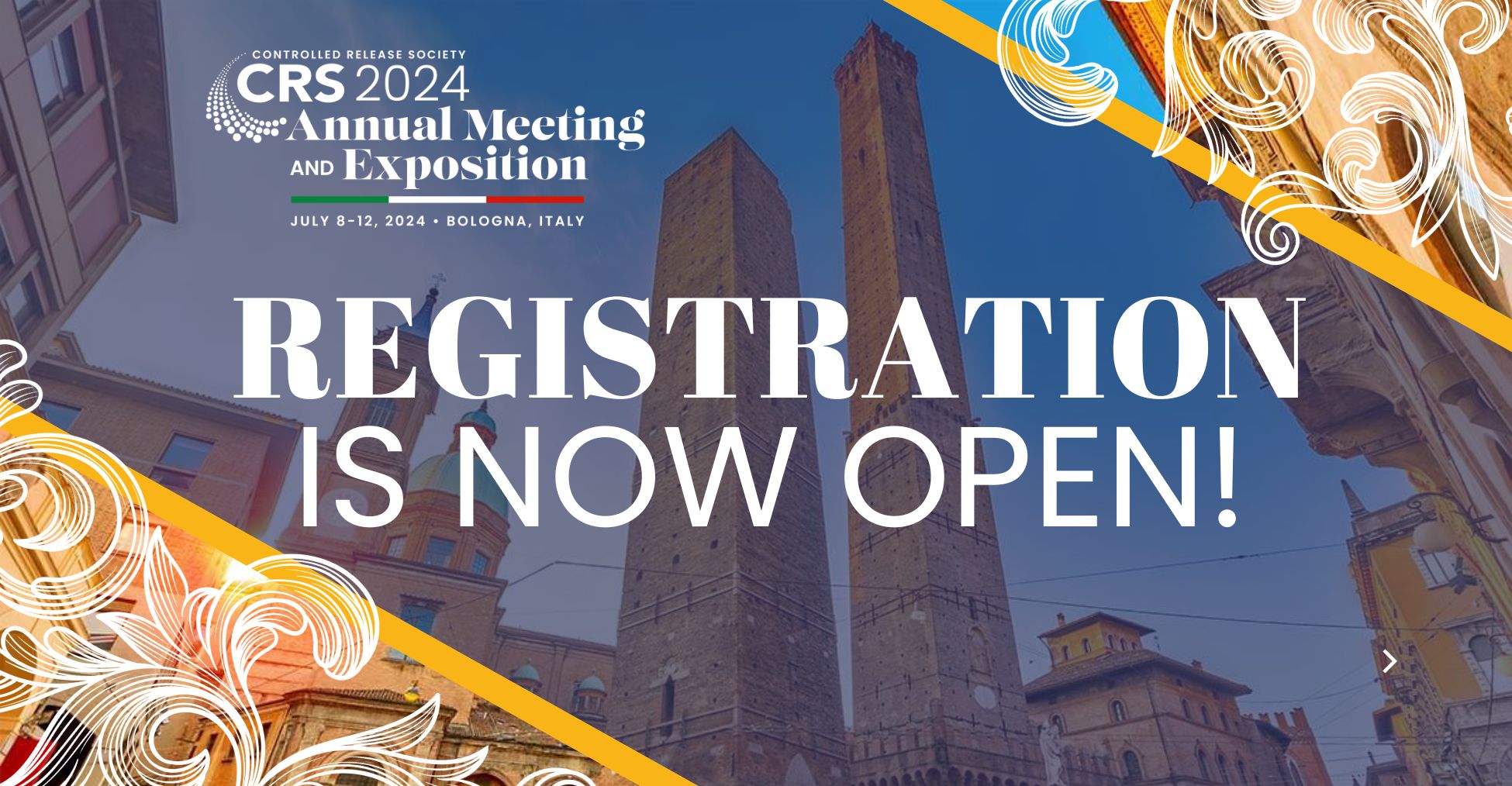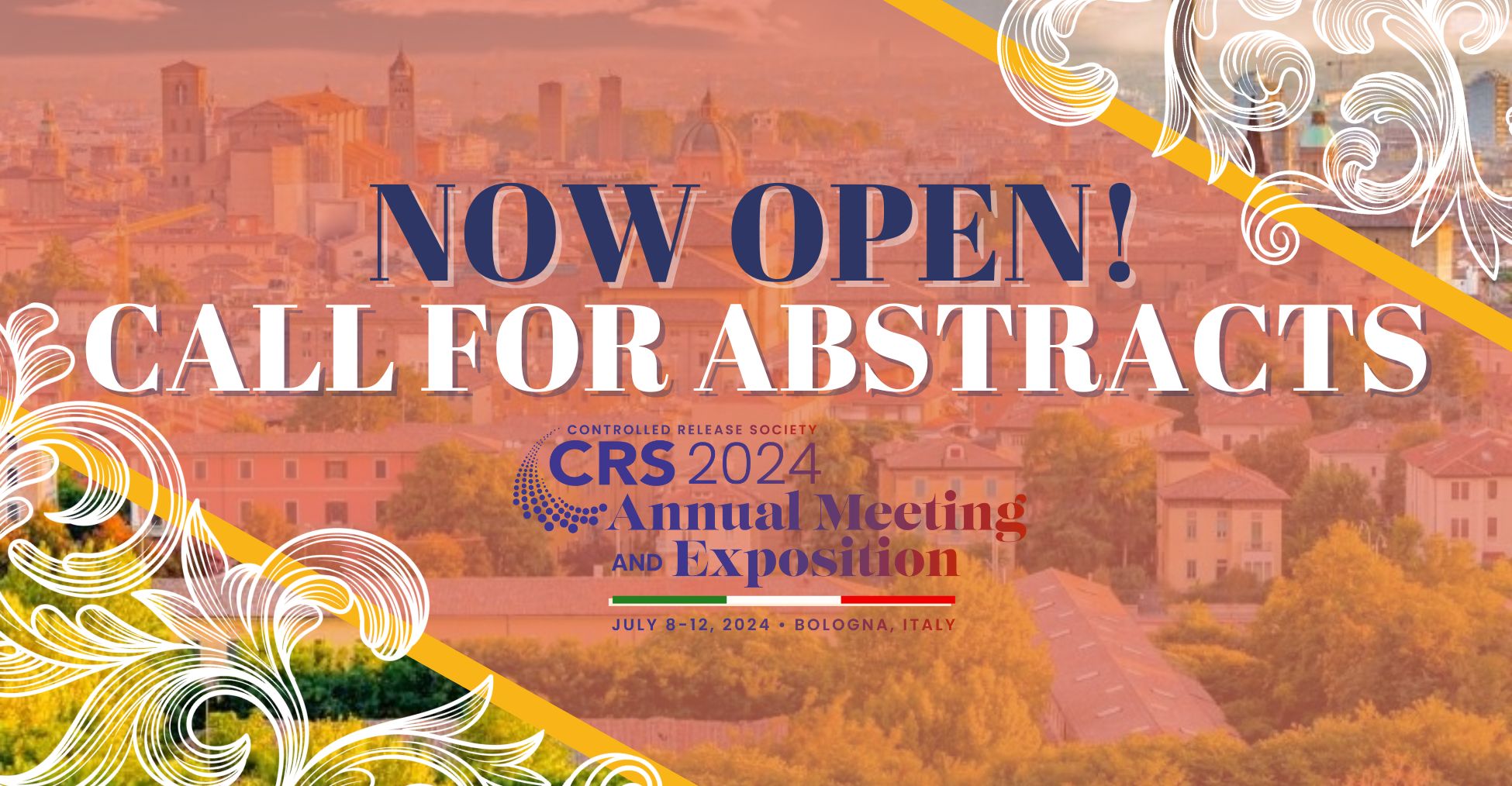May 30, 2024
About CRS
CRS is the home for experts dedicated to delivery science, including delivery scientists, engineers, clinicians, and technical professionals. CRS members are creating the future of delivery science and technology through fundamental delivery research, development, regulatory science, and clinical translation. Research published in CRS journals and presented during the Annual Meeting & Exposition offers a breadth of scientific knowledge covering new technologies and science in the multi-disciplinary delivery field.
Featured Videos
Featured Events
New This Month
CRS 2024 College of Fellows Nominations are OPEN!
CRS 2024 Board of Directors Election: Petition Period has Begun
View the slate
See new updates on CRS Member News
CRS 2024 Annual Meeting
Drug Delivery and Translational Research (DDTR)
What's New?
Check out the April Best Paper in Drug Delivery and Translational Research
April 2024 Best Paper
April 2024 Issue
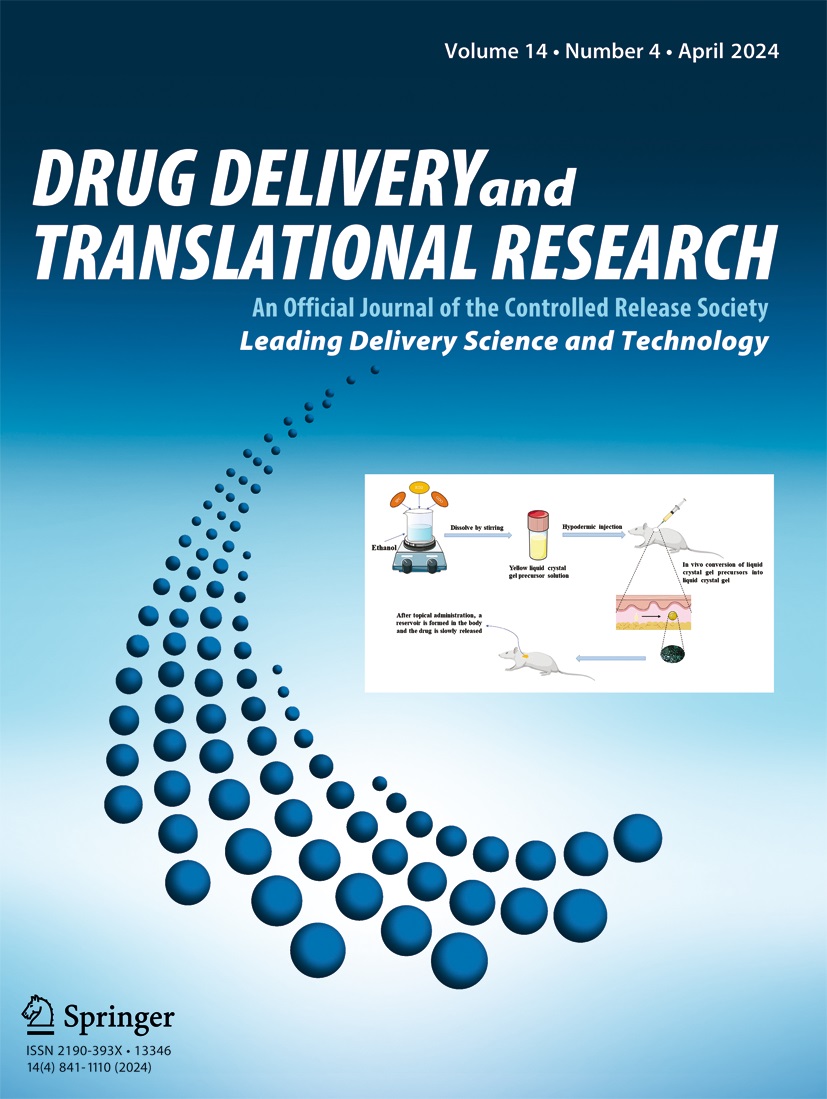
A liquid crystal in situ gel based on rotigotine for the treatment of Parkinson’s disease
https://link.springer.com/article/10.1007/s13346-023-01449-x
Rotigotine (RTG) is a dopamine agonist that exerts anti-Parkinsonian effects through dopamine receptor agonism to improve motor symptoms and overall performance in Parkinson’s disease (PD) patients. In this study, an in situ liquid crystal gel, rotigotine-gel (RTG-gel), was developed using soya phosphatidyl choline (SPC) and glycerol dioleate (GDO) to provide long-acting slow-release of rotigotine while minimizing side effects. The rheological properties of the RTG-gel precursor solution, prepared with SPC, GDO, and ethanol, indicate a favorable combination of low viscosity and excellent flowability. The gel that produced during water absorption was also highly viscous and structurally stable, which helped maintain the delayed drug release at the injection site. In vitro release of RTG-gel followed Ritger-Peppas. The RTG-gel precursor solution, following subcutaneous injection, exhibited the plasma elimination half-life (t1/2) of 59.28 ± 16.08 h, the time to peak blood concentration (Tmax) of 12.00 ± 10.32 h, and the peak concentration (Cmax) of 29.9 ± 10.10 ng/mL. The blood concentration remained above 0.1 ng/mL for 20 days after administration and was detectable after 31 days of administration, and the bioavailability of RTG reached 72.59%. In vitro solvent exchange tests revealed that the RTG-gel precursor solution underwent rapid exchange upon contact with PBS, and the diffusion of ethanol reached 48.1% within 60 min and 80% within 8 h. Cytotoxicity test showed 89.27 ± 4.32% cell survival after the administration of RTG-gel. The administration site exhibited healing without redness and hemorrhage after 14 days of injection. In addition, inflammatory cells decreased and granulation tissue appeared after 14 days of administration, and there was basically no inflammatory cell infiltration after 35 days of administration. Overall, RTG-gel might be a potential RTG extended-release formulation for treating PD.
Check out this highly informative and insightful Inspirational Note by Drs. Ryan Donnelly and Mark Prausnitz discussing
The Innovation of Microneedle Technologies for Drug Delivery Applications
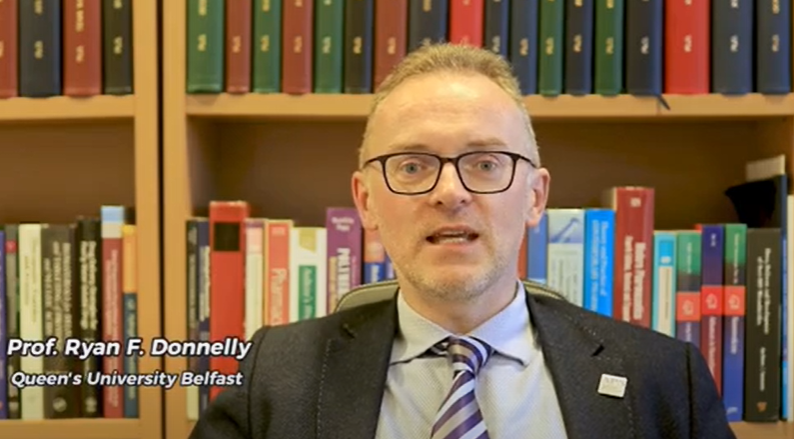
Intravenous injection of cyclosporin A loaded lipid nanocapsules fights inflammation and
immune system activation in a mouse model of diabetic retinopathy
Summary: https://link.springer.com/article/10.1007/s13346-023-01350-7
Inflammation and immune system activation are key pathologic events in the onset and
escalation of diabetic retinopathy (DR). Both are driven by cytokines and complement
originating from the retinal pigment epithelium (RPE). Despite the RPE’s pivotal role, there is no
therapeutic tool to specifically interfere with the RPE-mediated pathology of DR. Here, we
utilized lipoprotein-mimetic lipid nanocapsules to deliver the anti-inflammatory and
immunosuppressive drug cyclosporin A (CsA) to RPE cells. Using a mouse model of DR that
mirrors all pathologic aspects of human DR, we demonstrate that intravenously applied CsA-
loaded lipid nanocapsules comprehensively counteract inflammation and immune system
activation. One single injection suppressed the expression of pro-inflammatory cytokines,
dampened macrophage infiltration, and prevented macrophage and microglia activation in eyes
with DR. This work shows that CsA-loaded lipid nanocapsules can offer new avenues for the
treatment of DR.
Nebulizers Effectiveness on pulmonary delivery of alpha‑1 antitrypsin
Summary:https://link.springer.com/article/10.1007/s13346-023-01346-3
The administration of nebulized alpha-1 antitrypsin (AAT) to the lung represents an interesting
alternative to parenteral infusion for patients suffering from AAT genetic deficiency (AATD).
However, the nebulization of proteins can have a dramatic effect on their activity. In this paper, a
formulation of AAT for infusion was nebulized with a jet or a mesh vibrating system, whose
performance was compared in terms of aerosolization efficiency and preservation of AAT function.
The two nebulizers allowed satisfactory preservation of protein activity and provided equivalent
aerosolization performances, while the delivered dose was higher with the mesh vibrating system.
Nebulization of AAT proved to be a suitable administration strategy ready to be translated to the
clinical practice for direct lung delivery of the protein in AATD patients, either as a support therapy
to parenteral administration or, for subjects with a precocious diagnosis, as a means to prevent the
onset of pulmonary symptoms.
Neuronal differentiation and functional maturation of neurons from neural stem cells
induced by bFGF-chitosan controlled release system
Summary:https://link.springer.com/article/10.1007/s13346-023-01322-x
Available methods for differentiating stem cells into functional neurons require numerous
cytokines and neurotrophic factors, and the process is highly complex, slow, inefficient, and
costly for clinical implementation. Here, we demonstrate a bioactive material, basic fibroblast
growth factor (bFGF)-chitosan controlled release system, facilitates neuronal differentiation from
neural stem cells (NSCs) and the functional maturation of the induced neurons with high
efficiency. Immunostaining revealed that the neurons derived from NSCs expressed mature
immunomarkers of interneurons and excitatory neurons. We also found by patch-clamp that the
induced neurons exhibited diverse electrophysiological properties as well as functional
synapses. In vivo, we implanted bFGF-chitosan into lesion area in traumatic brain injury mice
and observed abundance of neuroblasts in subventricular zone and the presence of newborn
functional neurons in injury area, which integrated into synaptic networks. Taken together, our
efficient and rapid tissue engineering approach provides a means to generate functional
neuronal lineage cells from stem cells and potentially to treat brain injury and diseases.
Rapidly Dissolving Bilayer Microneedles Enable Minimally Invasive and Efficient Protein Delivery to the Posterior Segment of the Eye.- Best Paper August 2023 Issue
Summary
https://link.springer.com/article/10.1007/s13346-022-01190-x
The discovery of proteins that neutralize vascular endothelial growth factors can inhibit the
process of angiogenesis to restore eyesight in individuals with retinal vascular disorders.
However, a safe and effective means to deliver these protein drugs to the target posterior
segment is currently lacking. To this end, we developed dissolving bilayer microneedles (MNs)
possessing the potential to deliver proteins to the back of the eye in an efficient and minimally
invasive manner. A model protein, ovalbumin (OVA), was incorporated into MNs fabricated from
different polymers, including hyaluronic acid, polyvinyl alcohol (PVA) and polyvinylpyrrolidone
(PVP). Optimized PVA/PVP MNs demonstrated robust permeation of porcine sclera with > 75%
of the needle length penetrating the sclera while dissolving within 150 s. SDS-PAGE and OVA-
specific ELISA revealed that the bioactivity of OVA was retained during the manufacture of MNs.
In hen’s egg-chorioallantoic membrane test, MNs fabricated from all chosen polymers were
classified as non-irritants. Furthermore, ex vivo permeation studies showed that optimized MNs
mediated the penetration of 86.99 ± 7.37% of OVA through the sclera, twice that of the needle-
free patch (42.16 ± 3.95%), highlighting the capability of MNs to circumvent physical barriers
and promote protein delivery to the posterior segment of the eye. Overall, a novel, efficient, and
safe intraocular protein delivery system was successfully established.
ivery and Translational Research – Best Paper July 2023 Issue
Summary
Nanoparticle per-treatment for enhancing the survival and activation of pulmonary
macrophage transplant
Despite recent clinical successes of the chimeric antigen receptor T cell therapy in treating liquid
cancers, numerous challenges hamper its broader translation. Macrophage has been proposed
as an alternative given its abilities in promoting tumor infiltration, acquiring diverse antigens, and
continuously stimulating adaptive responses. However, poor survival of transplanted
macrophages and transient retention of anti-tumor phenotype have been major obstacles.
Leveraging on recent discoveries of nanoparticle strategies addressing these limitations, we
herein report enhanced survival and phenotypic retention of macrophage transplants in murine
lungs by pre-treatment with nanoparticles of varying degradation rates. Poly(ethylene glycol)
diacrylate nanoparticles prolonged survival of transplanted macrophages over untreated cells,
where nanoparticles increased the retention of transplanted cell counts by over 50%.
Furthermore, pre-treated macrophages more efficiently retained the pro-inflammatory-like
polarization state compared to macrophages pre-treated with a classical pro-inflammatory
stimulus, interferon-gamma, where CD86 costimulatory molecule expression was over 150%
greater in pre-treated macrophage transplants compared to untreated counterparts. These
findings provide an avenue for a major improvement in the lifespan and efficacy of macrophage-
based therapies and thus their broader therapeutic implementation.
Drug Delivery and Translational Research – Best Paper June 2023 Issue
Summary
Sustained antigens delivery using composite microneedles for effective
epicutaneous immunotherapy
Allergen-specific immunotherapy is an efficacious therapy for various allergic diseases such as
food allergy (FA). However, frequent clinical visits and potential adverse effects often hinder
patient compliance. Here, we proposed an implantable microneedle (MN) system composed of
OVA (antigen)-loaded silk MNs and a dissolvable, flexible polyvinyl alcohol (PVA) pedestal.
Once MNs are inserted into the skin, the PVA pedestal can quickly dissolve in the interstitial
fluid of the excised skin and implant the OVA-loaded silk MN tips in dermal layer as a sustained
antigen depot, thus inducing long-lasting immune response. After receiving 3 doses of MN-
based immunotherapy, the immune response in OVA-sensitized mice was successfully
suppressed, with no apparent side effects. Compared to conventional subcutaneous
immunotherapy, MN immunotherapy ameliorated systemic anaphylaxis more effectively even at
a lower dose, demonstrating the antigen dose-sparing potential of the proposed MNs. Moreover,
due to the prolonged release effect of silk-PVA composite MNs, the frequency of
immunotherapy can be significantly reduced. Overall, through prolonged skin exposure to
antigen, this implantable designed MN may offer a new therapeutic strategy for FA treatment
with significant improvements in efficacy and convenience.
Drug Delivery and Translational Research – Best Paper May 2023 Issue
Summary
Preterm born infants are often susceptible to necrotizing enterocolitis (NEC), a terrible disease associated with impaired intestinal barrier properties, and are often empirically treated with intravenous broad-spectrum antibiotics. Yet, it is unclear how this antibiotics exposure, as well as the way they are dosed, affects the intestinal barrier and minimizes the risk of developing NEC. We show that permeability rates through intestinal mucosa from piglets dosed with the combination of enteral and parenteral antibiotics were comparable to the rates in untreated piglets, whereas the piglets dosed with parenteral antibiotics had lower permeability rates. Interestingly, decreased permeability rates through the mucus alone were evident, suggesting that the change in the mucosa permeability to a large extent was caused by altered mucus permeability. Mixing the antibiotics with untreated mucus had no effect, suggesting that the altered properties of mucus were caused by other associated events induced by the antibiotics.
Drug Delivery and Translational Research – Best Paper April 2023 Issue
Summary
The analysis of gastrointestinal cellular permeation in pre-clinical drug development is widely
conducted, however the permeation of the overlying mucus layer is often overlooked. This is
attributed to a lack of understanding of the complexity of this layer, coupled with minimal
availability of experimental tools to quantify permeation through the turbid, viscous solution. Here,
a novel microfluidic device facilitates the observation of interactions between physicochemically
diverse nanocarriers and the mucin protein on a microscopic scale. This approach provides key
information on mucin-binding which may be lost with traditional methods and allows the
quantification of mucoadhesive as well as mucopermeating formulations. In addition, utilising a
complex biomimetic solution of proteins, lipids and salts which accurately mimics the chemistry and
rheology of native mucus within the device resulted in a 5.5-fold reduced permeation and 1.4-fold
reduced diffusivity of PLGA nanoparticles, compared to a more prevalent, simple mucus mimic.
Best Paper of the March 2023 Issue of DDTR (listed by corresponding authors):
Circular RNAs (circRNAs) are a class of highly stable and closed-loop noncoding RNA that are
involved in the occurrence and development of hepatocellular carcinoma (HCC). We found that
high circ_0058051 expression was negatively correlated with the prognosis of HCC patients.
We also showed here that circ_0058051 knockdown attenuated the proliferation and colony
formation, while inhibited migration of HCC cells. The findings underscore the potential of
circ_0058051 as a therapeutic target for HCC. We synthesized a novel small interfering RNA
(siRNA) delivery system, PEG-PCL-PEI-C14-SPIONs (PPPCSs), based on superparamagnetic
iron oxide nanoparticles (SPIONs). PPPCSs protected the siRNA of circ_0058051 from
degradation in serum and effectively delivered siRNA into SMMC-7721 cells. Meanwhile,
intravenous injection of the PPPCSs/siRNA complex could inhibit tumor growth in the
subcutaneous tumor model. In addition, the nanocomposite was not toxic to the organs of nude
mice. Collectively, PPPCSs/si-circ_0058051 complex may provide a novel and promising
method of HCC treatment.
Best Papers of the February 2023 Issue of DDTR (listed by corresponding authors):
Thymoquinone (TQ) is a quinone-based phenolic compound with antioxidant and anti-
inflammatory activities, but its therapeutic utility has been underexplored due to inadequate
biological stability, short half-life, low hydrophilicity, and poor systemic bioavailability.
Tamanu oil-stabilized nanostructured lipid carriers (TQ-NLCs) enriched with TQ were
prepared and optimized using Box-Behnken design with the size of 153.9 ± 0.5 nm and
surface charge of -30.7 mV. The encapsulation efficiency and drug loading density were
found to be 84.6 ± 0.5 % and 14.8 ± 0.5 %, respectively. The TQ-NLCs assayed for skin
permeation for transdermal delivery where TQ-NLC provided roughly 15 times greater
permeation compared to aqueous solution of TQ. Tamanu oil displayed a synergistic anti-
inflammatory potential with TQ in comparison to TQ alone in carrageenan-induced paw
oedema model and Freund's adjuvant-induced arthritic model. The arthritic and X-ray scores
significantly reduced in TQ-NLC-treated and standard formulation-treated groups. Moreover,
serum pro-inflammatory TNF-α and IL-6 levels were significantly reduced in TQ-NLC-treated
group compared to the arthritic control group.
Best Papers of the December 2022 Issue of DDTR (listed by corresponding authors):
Summary: We introduce a novel antiviral nano-drug called SNAT (Smart Nano-Enabled
Antiviral Therapeutic) composed of taxoid (Tx)-decorated amino (NH 2 )-functionalized silver
nanoparticles (Tx–[NH 2 -AgNPs]). The particles are around 5 nm in diameter, positively charged
and stable for over three years at room temperature. We assessed the preclinical efficacy of
inhaled SNAT where we found that SNAP significantly reversed the body weight loss, reduced
the virus load in oral swabs, and improved lung health of hamsters infected with SARS-CoV-2.
Further, SNAT was found to be noncytotoxic and antioxidant, potentially quenching lipid
peroxidation, in human lung epithelial cells and dermal fibroblasts. Overall, our study
collectively highlights SNAT as a safe and potent antiviral platform against SARS-CoV-2
infection and potentially other respiratory viruses of epidemic and pandemic potential.
Perspective

Role of drug delivery technologies in the success of COVID-19 vaccines: a perspective
This newly published DDTR “Perspective” article discusses the roles of drug delivery technologies in developing safe and efficacious vaccines. We thank Drs. Robert Langer, Pieter Cullis, Olivia Merkel and Mark Prausnitz for sharing their perspectives and insights on this important topic.
Inspirational Note

This newly released Inspirational Note discusses critical considerations for the clinical implementation of nanomedicine.

Inspirational note by Martin J. Whitaker, Hiep Huatan and Richard J. Ross
This Inspirational Note features innovative drug delivery technology that replicates the physiological cortisol diurnal rhythm for chronotherapy.

Inspirational note by James Goodson and Dr. Paul Rota
In this inspirational note, James Goodson and Dr. Paul Rota provide insightful and timely perspective and discussion regarding the importance of vaccine delivery technology and multidisciplinary efforts to achieve global vaccination and ultimately well-being.

Inspirational note by Dr. Andrew L. Lewis
Development and approval of rybelsus (oral semaglutide): ushering in a new era in peptide delivery
In this Inspirational Note, Dr. Andrew Lewis and coauthors feature an amazing and innovative discovery that is changing the paradigm of oral peptide delivery.

Inspirational note by Drs. Lara Milane and Mansoor Amiji
In this Inspirational Note, Drs. Lara Milane and Mansoor Amiji share their insights and reflections on the impact of the recently approved SARS-CoV-2 mRNA vaccines on the present and future of translational nanomedicines.

Inspirational note by Alexander (Sandy) T. Florence Trajectories in nanotechnology: embracing complexity, seeking analogies
"A timely and truly insightful Inspirational Note by one of the fathers of nanotechnology & pharmaceuticals.” -Jung Soo Suk, Ph.D., Assistant Professor, The Center for Nanomedicine at the Wilmer Eye Institute, Johns Hopkins University School of Medicine
Inspirational Note from Dr. Marianne Ashford, Senior Principal Scientist in Glocal Advanced Drug Delivery Group in Pharmaceutical Sciences at AstraZeneca "Drug delivery - the increasing momentum"
"In this 'Inspirational Note' you will be inspired by the way industry sees advances in drug delivery and Nanomedicine. Dr. Marianne Ashford talks about the 'increasing momentum'. You should not miss this note if you are interested in translational research." -Prof. Maria José Alonso, Editor-in-Chief of the Drug Delivery and Translational Research (DDTR) Journal, Past President of the Controlled Release Society

Inspirational Note from Dr. Robert Langer
"From micro to nano: evolution and impact of drug delivery in treating disease"
In this Inspirational Note, Robert Langer and Jeff Hrkach highlight the technological evolution of drug delivery from micro to nano, providing examples of clinically approved medicines that demonstrate the significant impact of the drug delivery field on treating many diseases.
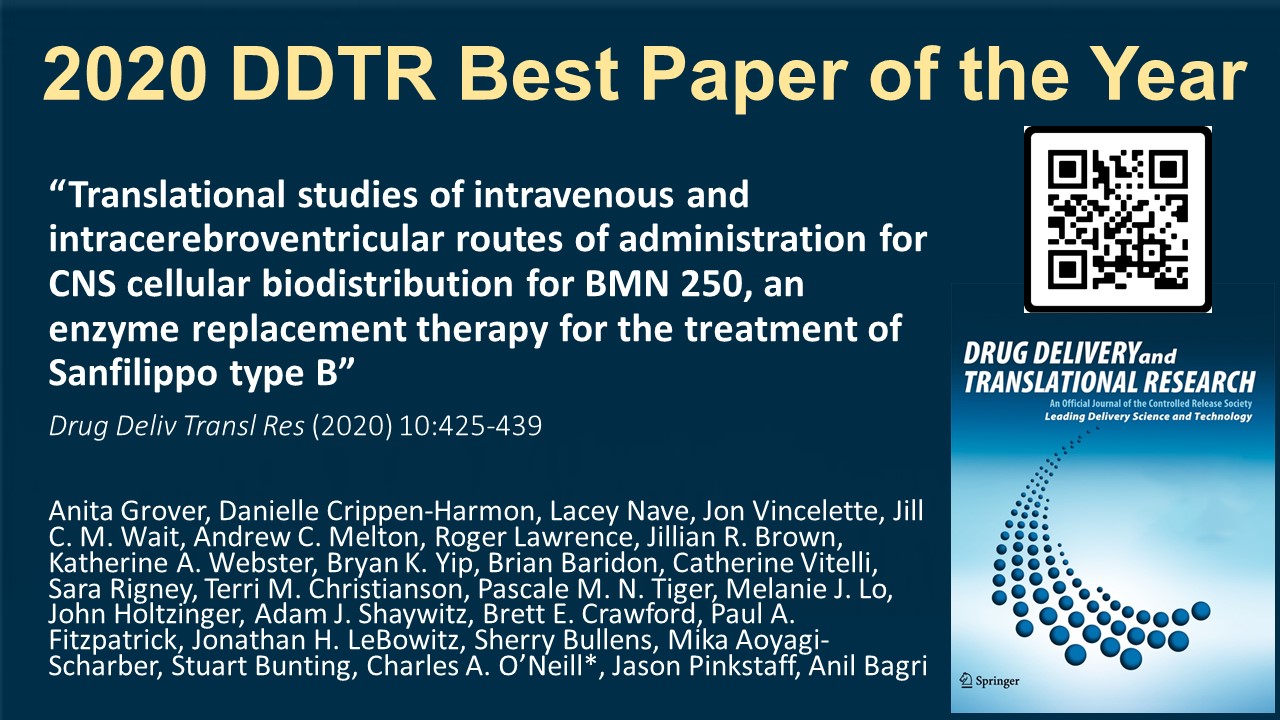
2020 DDTR Best Paper of the Year: Translational studies of intravenous and intracerebroventricular routes of administration for CNS cellular biodistribution for BMN 250, an enzyme replacement therapy for the treatment of Sanfilippo type B.
2019 DDTR Best Paper of the Year: Depletion of collagen by losartan to improve tumor accumulation and therapeutic efficacy of photodynamic nanoplatforms
The Best Paper is chosen by the DDTR Editorial Board.

2019 CRS Nanomedicine and Nanoscale Delivery (NND) Best Paper of the Year: Tumor growth inhibition by mSTEAP peptide nanovaccine inducing augmented CD8+ T cell immune responses

2019 DDTR CRS Oral Drug Delivery Focus Group Paper of the Year Award: Loratadine self-microemulsifying drug delivery systems (SMEDDS) in combination with sulforaphane for the synergistic chemoprevention of pancreatic cancer

DDTR Videos
Drug Delivery and Translational Research is a journal published by CRS, providing a unique forum for the scientific publication of high-quality research that is exclusively focused on translational aspects of drug delivery. The journal is published 6 times a year and will be available online to CRS members as part of their annual dues.
Drug Delivery and Translational Research Editors
Drug Delivery and Translational Research Editorial Board
Women In Science
'
Welcome to the WIS Group, a dynamic community dedicated to showcasing the achievements and fostering the career growth of women in Delivery Sciences and Technologies. Our mission is to create a supportive environment that nurtures professional development at every career stage. As we strive to be a leading voice in scientific, educational, translational, and business sectors, we invite you to join us in celebrating and advancing the contributions of women in our field.
At the heart of our mission lies the commitment of the CRS, a society teeming with vigor, dedicated to equipping our community with cutting-edge tools and knowledge. We are devoted to organizing a series of online webinars that embody the essence of empowerment and personal growth, both in personal and professional life. Furthermore, our agenda has an extensive array of invaluable soft skills sessions, designed to nurture and empower our members on their journey of excellence.



